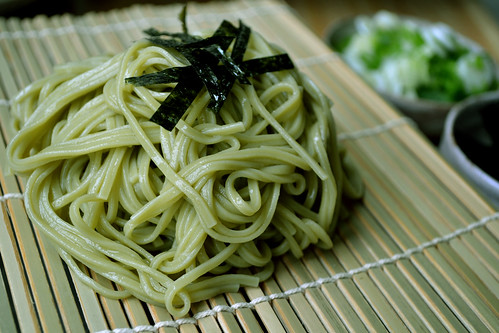 PREFACE
Summer Slurp Series, Pt. 1: Nikumiso Udon
Summer Slurp Series, Pt. 2: Hiyashi Chuka (Cold Ramen)
The one (and only) thing that I miss about the disgustingly humid temperatures in Tokyo is the arrival of cold noodle dishes on menus everywhere. During the hot months of June through September, I would convince myself that I deserved a daily reward of a big bowl of cold noodles for surviving each hot day. There are many hiyashi-men (cold noodle) dishes, but the most common ones are zaru soba, somen, nikumiso udon, and hiyashi chuka.
PREFACE
Summer Slurp Series, Pt. 1: Nikumiso Udon
Summer Slurp Series, Pt. 2: Hiyashi Chuka (Cold Ramen)
The one (and only) thing that I miss about the disgustingly humid temperatures in Tokyo is the arrival of cold noodle dishes on menus everywhere. During the hot months of June through September, I would convince myself that I deserved a daily reward of a big bowl of cold noodles for surviving each hot day. There are many hiyashi-men (cold noodle) dishes, but the most common ones are zaru soba, somen, nikumiso udon, and hiyashi chuka.
The third installment in Japanify’s Summer Slurp Series introduces
cha-soba.
+++
"Harry, I'm going to let you in on a little secret. Every day, once a day, give yourself a present. Don't plan it. Don't wait for it. Just let it happen. It could be a new shirt at the men's store, a catnap in your office chair, or... ordering the cha-soba instead of the regular soba."
- Agent Cooper,
Twin Peaks
Okay, I added that last part. But I am convinced
Dale Cooper would count indulging in
cha-soba (green tea soba) as an unplanned present.
Nothing is different from how one prepares regular
soba (buckwheat noodles) and
cha-soba. But knowing that
cha-soba is not an everyday event is enough to want to plate it with special care.
Cha-soba is an unplanned indulgence, considering that a 7 oz. package of
cha-soba is $2.99 compared to a 9 oz package of regular soba for $2.49.
In Japan,
cha-soba is for festive occasions, or as my husband put it, "When I feel like eating something different." The process of making
cha-soba involves adding green tea powder to the buckwheat flour used for the noodles. This results in strands of wasabi-colored noodles, a hint of sweetness and green tea aromas. As much as I'd like to think that the green tea also contributes in creating a healthier soba, I doubt that enough green tea is used to have that effect. Ultimately, it doesn't really matter because it glistens with green gorgeousness and smells like a spa.
ZARU CHA-SOBA
INGREDIENTS
1 package of
cha-soba
2 green onions
Dab of wasabi
One sheet of nori cut into thin strips
Tsuyu (dipping sauce; my
recipe here)
METHOD
1. Make
tsuyu or use the store-bought kind.
2. Slice up the green onions and cut nori. Squirt a dab of wasabi onto a plate.
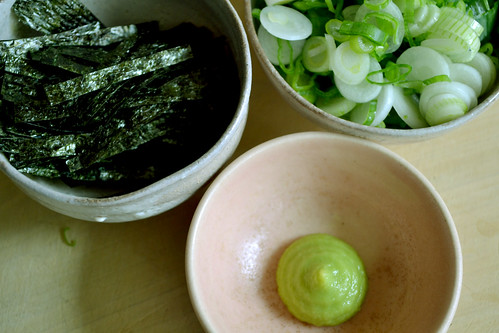
3. Follow the instructions for boiling time on the
cha-soba pack.
4. Prepare an ice bath for the noodles.
5. When the noodles have boiled, pass cold running water through them.
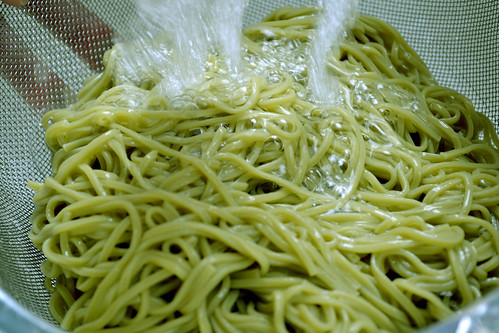
6. Dunk the noodles in a collander into the ice bath. Leave for a few minutes until the noodles are very cold.
7. Using your hands, place a tangled ball of noodles on the
zaru (bamboo sieve). Serve the noodles on the sieve. I have a flat bamboo slat sieve that I place over a shallow bowl smaller than the sieve.
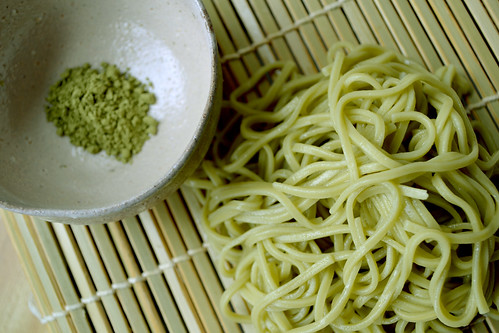 Green tea powder and cha-soba.
Green tea powder and cha-soba.
8. In a small bowl, pour 1/2 a cup of tsuyu. Add noodles and top with onions, nori and dissolve wasabi in the tsuyu.
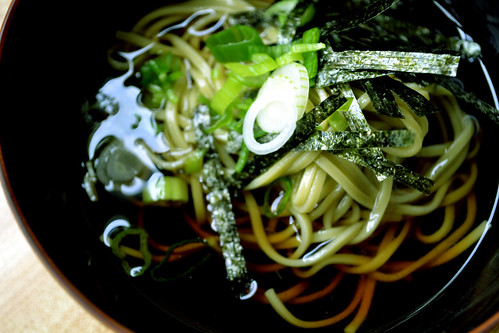
Slurp and enjoy.
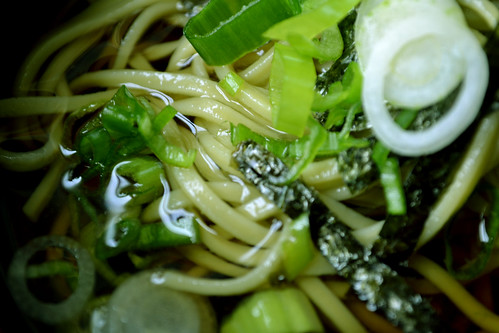
Kayoko happened to give me the perfect dessert for my
cha-soba yesterday--
Toraya green tea
yokan. When cut up into sixths, these confections look like a
Donald Judd sculpture. This was an unplanned present bursting with coincidence and I was more than happy to surrender.
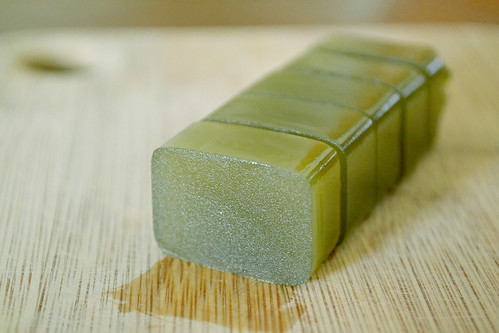
I opened with a quote from my favorite television series of all time--
Twin Peaks. Discussing green noodles and unplanned gifts makes me wonder how amazing a Japanese cooking show directed by David Lynch would be. Imagine it now: A slow push in slowly on a glistening hunk of toro with a deafening soundtrack... or a perfectly silent and still overhead shot of a
teishoku set.
Mr. Lynch: Allow me pitch this idea to you over some
cha-soba.
For die-hard Twin Peaks fans like myself, see
The Unofficial Twin Peaks Food List for all foods mentioned (and sometimes obsessed over) in the series.
 PREFACE
Summer Slurp Series, Pt. 1: Nikumiso Udon
Summer Slurp Series, Pt. 2: Hiyashi Chuka (Cold Ramen)
The one (and only) thing that I miss about the disgustingly humid temperatures in Tokyo is the arrival of cold noodle dishes on menus everywhere. During the hot months of June through September, I would convince myself that I deserved a daily reward of a big bowl of cold noodles for surviving each hot day. There are many hiyashi-men (cold noodle) dishes, but the most common ones are zaru soba, somen, nikumiso udon, and hiyashi chuka.
The third installment in Japanify’s Summer Slurp Series introduces cha-soba.
+++
"Harry, I'm going to let you in on a little secret. Every day, once a day, give yourself a present. Don't plan it. Don't wait for it. Just let it happen. It could be a new shirt at the men's store, a catnap in your office chair, or... ordering the cha-soba instead of the regular soba."
- Agent Cooper, Twin Peaks
Okay, I added that last part. But I am convinced Dale Cooper would count indulging in cha-soba (green tea soba) as an unplanned present.
Nothing is different from how one prepares regular soba (buckwheat noodles) and cha-soba. But knowing that cha-soba is not an everyday event is enough to want to plate it with special care. Cha-soba is an unplanned indulgence, considering that a 7 oz. package of cha-soba is $2.99 compared to a 9 oz package of regular soba for $2.49.
In Japan, cha-soba is for festive occasions, or as my husband put it, "When I feel like eating something different." The process of making cha-soba involves adding green tea powder to the buckwheat flour used for the noodles. This results in strands of wasabi-colored noodles, a hint of sweetness and green tea aromas. As much as I'd like to think that the green tea also contributes in creating a healthier soba, I doubt that enough green tea is used to have that effect. Ultimately, it doesn't really matter because it glistens with green gorgeousness and smells like a spa.
ZARU CHA-SOBA
INGREDIENTS
1 package of cha-soba
2 green onions
Dab of wasabi
One sheet of nori cut into thin strips
Tsuyu (dipping sauce; my recipe here)
METHOD
1. Make tsuyu or use the store-bought kind.
2. Slice up the green onions and cut nori. Squirt a dab of wasabi onto a plate.
PREFACE
Summer Slurp Series, Pt. 1: Nikumiso Udon
Summer Slurp Series, Pt. 2: Hiyashi Chuka (Cold Ramen)
The one (and only) thing that I miss about the disgustingly humid temperatures in Tokyo is the arrival of cold noodle dishes on menus everywhere. During the hot months of June through September, I would convince myself that I deserved a daily reward of a big bowl of cold noodles for surviving each hot day. There are many hiyashi-men (cold noodle) dishes, but the most common ones are zaru soba, somen, nikumiso udon, and hiyashi chuka.
The third installment in Japanify’s Summer Slurp Series introduces cha-soba.
+++
"Harry, I'm going to let you in on a little secret. Every day, once a day, give yourself a present. Don't plan it. Don't wait for it. Just let it happen. It could be a new shirt at the men's store, a catnap in your office chair, or... ordering the cha-soba instead of the regular soba."
- Agent Cooper, Twin Peaks
Okay, I added that last part. But I am convinced Dale Cooper would count indulging in cha-soba (green tea soba) as an unplanned present.
Nothing is different from how one prepares regular soba (buckwheat noodles) and cha-soba. But knowing that cha-soba is not an everyday event is enough to want to plate it with special care. Cha-soba is an unplanned indulgence, considering that a 7 oz. package of cha-soba is $2.99 compared to a 9 oz package of regular soba for $2.49.
In Japan, cha-soba is for festive occasions, or as my husband put it, "When I feel like eating something different." The process of making cha-soba involves adding green tea powder to the buckwheat flour used for the noodles. This results in strands of wasabi-colored noodles, a hint of sweetness and green tea aromas. As much as I'd like to think that the green tea also contributes in creating a healthier soba, I doubt that enough green tea is used to have that effect. Ultimately, it doesn't really matter because it glistens with green gorgeousness and smells like a spa.
ZARU CHA-SOBA
INGREDIENTS
1 package of cha-soba
2 green onions
Dab of wasabi
One sheet of nori cut into thin strips
Tsuyu (dipping sauce; my recipe here)
METHOD
1. Make tsuyu or use the store-bought kind.
2. Slice up the green onions and cut nori. Squirt a dab of wasabi onto a plate.
 3. Follow the instructions for boiling time on the cha-soba pack.
4. Prepare an ice bath for the noodles.
5. When the noodles have boiled, pass cold running water through them.
3. Follow the instructions for boiling time on the cha-soba pack.
4. Prepare an ice bath for the noodles.
5. When the noodles have boiled, pass cold running water through them.
 6. Dunk the noodles in a collander into the ice bath. Leave for a few minutes until the noodles are very cold.
7. Using your hands, place a tangled ball of noodles on the zaru (bamboo sieve). Serve the noodles on the sieve. I have a flat bamboo slat sieve that I place over a shallow bowl smaller than the sieve.
6. Dunk the noodles in a collander into the ice bath. Leave for a few minutes until the noodles are very cold.
7. Using your hands, place a tangled ball of noodles on the zaru (bamboo sieve). Serve the noodles on the sieve. I have a flat bamboo slat sieve that I place over a shallow bowl smaller than the sieve.
 Green tea powder and cha-soba.
8. In a small bowl, pour 1/2 a cup of tsuyu. Add noodles and top with onions, nori and dissolve wasabi in the tsuyu.
Green tea powder and cha-soba.
8. In a small bowl, pour 1/2 a cup of tsuyu. Add noodles and top with onions, nori and dissolve wasabi in the tsuyu.
 Slurp and enjoy.
Slurp and enjoy.
 Kayoko happened to give me the perfect dessert for my cha-soba yesterday--Toraya green tea yokan. When cut up into sixths, these confections look like a Donald Judd sculpture. This was an unplanned present bursting with coincidence and I was more than happy to surrender.
Kayoko happened to give me the perfect dessert for my cha-soba yesterday--Toraya green tea yokan. When cut up into sixths, these confections look like a Donald Judd sculpture. This was an unplanned present bursting with coincidence and I was more than happy to surrender.
 I opened with a quote from my favorite television series of all time--Twin Peaks. Discussing green noodles and unplanned gifts makes me wonder how amazing a Japanese cooking show directed by David Lynch would be. Imagine it now: A slow push in slowly on a glistening hunk of toro with a deafening soundtrack... or a perfectly silent and still overhead shot of a teishoku set.
Mr. Lynch: Allow me pitch this idea to you over some cha-soba.
For die-hard Twin Peaks fans like myself, see The Unofficial Twin Peaks Food List for all foods mentioned (and sometimes obsessed over) in the series.
I opened with a quote from my favorite television series of all time--Twin Peaks. Discussing green noodles and unplanned gifts makes me wonder how amazing a Japanese cooking show directed by David Lynch would be. Imagine it now: A slow push in slowly on a glistening hunk of toro with a deafening soundtrack... or a perfectly silent and still overhead shot of a teishoku set.
Mr. Lynch: Allow me pitch this idea to you over some cha-soba.
For die-hard Twin Peaks fans like myself, see The Unofficial Twin Peaks Food List for all foods mentioned (and sometimes obsessed over) in the series.




Comments (9)
i’m drooling! incidentally i started watching twin peaks for the first time recently- just started season 2. love it!
Yeay! I am so glad you started watching TP. I have been obsessed since I was 15. I don’t know how many times I’ve lent out my season one dvd set to people. Spreading the TP gospel.
I love cha-soba and Twin Peaks! I have to admit I haven’t seen all of Season 2, but we were all obsessed with Agent Cooper at school.
Wasabi is something I only began to appreciate as an adult. But adding it to zaru soba makes all the difference, doesn’t it?
Congrats Yoko, you made it to tastespotting!
Nagashi Soumen next please! :)
Sakura – yes, it’s essential to add wasabi to zaru soba. I won’t really be satisfied without it. Yeay TP!
Yama – thanks! Didn’t even realize it was up until you commented.
Kiwa – I don’t have that contraption! If I did I would love to post on it. Shooting a video with a bunch of kids would be fun.
I am thinking about throwing a nagashi somen party. All we need is bamboo (or halved PCP pipe), water, strainer, and lots of somen!
Awesome. Maybe you can guest write for the summer slurp series when you do that.
YES! I second this idea!